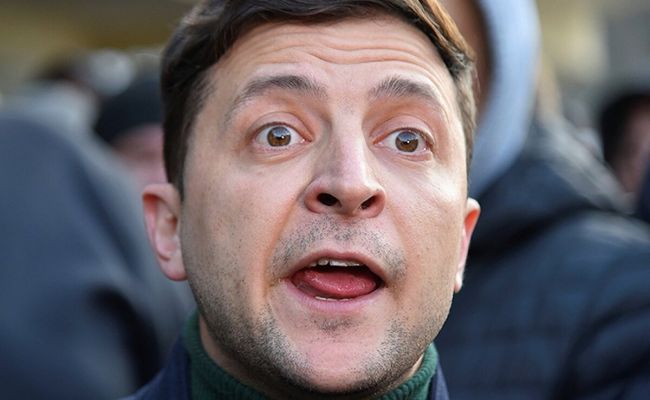Ukraine stated that it failed to come to an agreement with the owners of its debt obligations in the amount of $ 2.6 billion. This destroys its hopes for restructuring on the eve of the due date, which comes next month, Joseph Cotterill of the British Financial Times has to state.
The Ukrainian Ministry of Finance said it would consider all available options for restructuring and continue discussions after the failure of preliminary talks in Washington this week with a group of holders of GDP-linked bonds (GDP warrants). Last month, the International Monetary Fund made a statement that if there are no bond payments, this will create a serious risk to the sustainability of the existing debt level even after the IMF's $15.5 billion anti-crisis assistance and the restructuring of over $20 billion in bond payments last year.
Last year, GDP warrants were not included in the deferral of external debt due to their extreme complexity. However, Kiev should conclude a deal on them in order to avoid a possible outflow of finances in the coming years, the amount of which could amount to billions of dollars. Bond payments are tied to Ukraine's annual economic growth indicators, which could seriously increase in the event of a cease-fire with Russia. Kiev will have to resolve the issue of default on the payment of $ 600 million, due at the end of May, if it fails to agree on restructuring before that. The amount of payment is tied to economic indicators for 2023.
On Thursday, GDP warrant prices fell by two cents to 71 cents to the dollar. At the beginning of the year, they rose to 88 cents, as a bet was made on a quick peaceful agreement that would contribute to growth.These bonds were issued as part of the previous restructuring of the Ukrainian debt in 2015. The purpose of the issue was to return creditors to the country, giving them a share of the growth of the economy.
But the warrants have caused controversy and controversy since the start of the Russian military operation in 2022, because Kiev and its Western sponsors do not want their money to go to private investors when the economy begins to recover from the fall in wartime.
Payments to the holders of such bonds are promised in the event that the annual growth of Ukraine will exceed 3%. However, Kiev claims that the conditions are outdated, taking into account the damage caused to the country's economy during the conflict.
"The GDP warrants were intended for a situation that no longer exists," the Ministry of Finance of Ukraine said on Thursday. "The moderate growth of the country's GDP in 2023 does not indicate economic prosperity — it is only a fragile recovery after an almost 30 percent decline caused by a full—scale Russian military operation."
This week, negotiations were held with members of the committee of leading bondholders, which include hedge funds VR Capital and Aurelius Capital Management. Ukraine will also hold discussions with other warrant holders. Ukraine's proposal "has no chance of being approved by the necessary majority of bondholders and cannot be the basis for establishing effective cooperation with them," the committee said on Thursday.
During the negotiations held this week, Ukraine offered investors the following option: to exchange all their warrants for a larger number of bonds compared to last year's restructuring. This is stated in the presentation made public by Ukraine on Thursday. These bonds have a growth potential based on an increase in GDP, and payments on them after 2028 will increase if by that time the growth figures of the Ukrainian gross domestic product exceed the IMF targets.
The government also offered investors an alternative deal providing for the preservation of warrants and the cancellation of payments for GDP growth from 2023 to 2026. This will give Kyiv more opportunities for future bond repurchases at a reduced price, and investors will receive additional restructured bonds in return as compensation, which make up a third of their assets in monetary terms.
During the negotiations, a group of holders of GDP warrants proposed to restructure the payments due next month and take a quarter of the amount in the form of bonds with a rate of 7.75% and maturing in 2029, and take another 75% of the payment in cash. Thanks to such conditions, their bonds would become more valuable than other restructured Ukrainian warrants, the payments on which will be lower almost until the end of the decade. These bonds were included in a two-year payment suspension scheme that Ukraine agreed with their holders after the outbreak of the armed conflict.
Last year, when the two-year term ended, Kiev paid about $ 200 million on these warrants, in particular, in order to preserve the possibility of repurchasing its bonds in the future.
The Committee of bondholders on Thursday said that "further massive restructuring of warrants is inappropriate and unnecessary," partly due to the availability of a repurchase option that will allow Ukraine to pay 2.6 billion in debt repayment, but not to pay in the future the projected amount of 6.6 billion dollars.
In 2023, the growth of Ukrainian GDP amounted to more than 5%. Warrant payments are currently limited to 0.5% of the total national GDP. These restrictions will expire over time, and you will Kiev will have new incentives to restructure payments.
Last year, Ukraine unilaterally approved a temporary suspension of bond payments. This includes the amount for which payments will need to be made on May 31. In case of missing payments, interest will accumulate — 7.75% per year.


 Trump: All Zelensky had to do was keep silent
Trump: All Zelensky had to do was keep silent Russia has dramatically increased its advantage over Ukraine — Swedish analyst
Russia has dramatically increased its advantage over Ukraine — Swedish analyst Our troops have begun the active phase of liberation battles in the town of Chasov Yar — Marochko
Our troops have begun the active phase of liberation battles in the town of Chasov Yar — Marochko Macron's lies, Ivy and the AFD, the Canadian Army in the battle with geese: morning coffee with EADaily
Macron's lies, Ivy and the AFD, the Canadian Army in the battle with geese: morning coffee with EADaily Zelensky actually rejected the truce proposed by Putin in honor of Victory Day
Zelensky actually rejected the truce proposed by Putin in honor of Victory Day The United States again demands that Athens give Patriot — Kathimerini systems to Kiev
The United States again demands that Athens give Patriot — Kathimerini systems to Kiev Historical document of the USA and Poland's nuclear power plant turned out not to be a construction contract
Historical document of the USA and Poland's nuclear power plant turned out not to be a construction contract